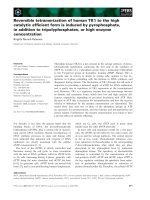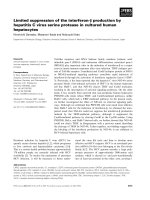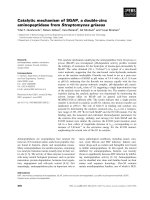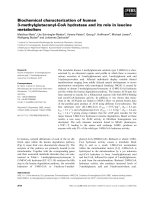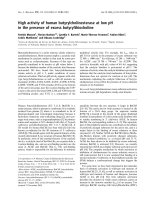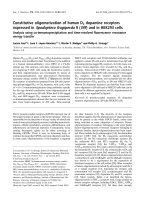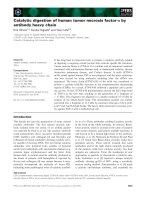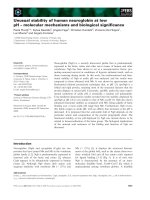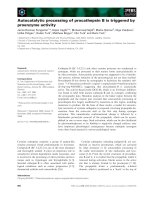Báo cáo khoa học: Catalytic digestion of human tumor necrosis factor-a by antibody heavy chain pot
Bạn đang xem bản rút gọn của tài liệu. Xem và tải ngay bản đầy đủ của tài liệu tại đây (757.83 KB, 10 trang )
Catalytic digestion of human tumor necrosis factor-a by
antibody heavy chain
Emi Hifumi
1,2
, Kyohei Higashi
3
and Taizo Uda
2,3
1 Research Center for Applied Medical Engineering, Oita University, Japan
2 CREST of JST (Japan Science and Technology Corporation), Kawaguchi, Saitama, Japan
3 Faculty of Engineering, Oita University, Japan
Introduction
This decade has seen the preparation of many natural
catalytic antibodies. The first natural catalytic anti-
body isolated from the serum of an asthma patient
was reported by Paul et al. [1]. The catalytic antibody
could enzymatically cleave vasoactive intestinal peptide
(VIP). Gabibov and colleagues [2] and Nevinsky and
colleagues [3] found antibodies showing catalytic activ-
ity capable of cleaving DNA. The two former catalytic
antibodies were prepared from samples of humoral
serum from individuals with autoimmune diseases (e.g.
systemic lupus erythematosus) and the latter from
human milk. A natural catalytic antibody produced in
the serum of patients with hemophilia A reported by
Kaveri and colleagues [4] was unique because it enzy-
matically decomposed the molecule of factor VIII,
indicating some pathological roles of catalytic antibod-
ies in vivo. These antibodies exhibited catalytic activity
in the form of the whole antibody. In contrast, Bence-
Jones protein, which is secreted in the urine of patients
with certain diseases, particularly multiple myeloma, is
well known to be a human light chain of the antibody.
Matsuura et al. [5], Matsuura & Sinohara [6] and Paul
et al. [7] found that Bence-Jones proteins could have
peptidase activity. These reports revealed that some
antibodies and ⁄ or the light chains naturally produced
in the patients could have catalytic activity, but their
antigens are unknown. From the standpoint of new
approaches to generate or characterize a catalytic anti-
body, Gololobov et al. [8] reported a unique catalytic
antibody cleaving gp120 of HIV, using a covalently
reactive analog method. Ponomarenko et al. [9] made
a catalytic anti-idiotype antibody, and examined the
Keywords
catalytic antibody; cytokine; proteolysis;
TNF-a
Correspondence
T. Uda, Oita University, Faculty of
Engineering, 700 Dannoharu, Oita-shi, Oita
870-1192, Japan
Fax: +81 97 554 7892
Tel: +81 97 554 7892
E-mail:
(Received 10 April 2010, revised 19 June
2010, accepted 21 July 2010)
doi:10.1111/j.1742-4658.2010.07785.x
It has long been an important task to prepare a catalytic antibody capable
of digesting a targeting crucial protein that controls specific life functions.
Tumor necrosis factor-a (TNF-a) is a cytokine and an important molecule
concerned with autoimmune diseases such as rheumatoid arthritis, chronic
obstructive pulmonary disease, and Crohn’s disease. A mAb (ETNF-6
mAb) raised against human TNF-a was prepared, and the steric conforma-
tion was created by using molecular modeling after the cDNA was
sequenced. The heavy chain (ETNF-6-H) of the mAb was considered to
possess a catalytic triad-like structure in the complementarity determining
regions (CDRs). As a result, ETNF-6-H exhibited a peptidase and a prote-
ase activity. In fact, ETNF-6-H predominantly cleaved the Ser5-Arg6 bond
of TNF-a at the first step, resulting in the generation of a fragment of
17 kDa. This fragment was digested to a smaller molecule of 15 kDa by
scission of the Gln21-Ala22 bond. The intermediate product was further
converted into a fragment of 13.3 kDa by successive cleavage of the Leu36-
Leu37 and Asn39-Gly40 bonds. The heavy chain possessed a protease activ-
ity against TNF-a with a multicleavage site.
Abbreviations
CDR, complementarity determining region; ETNF-6-H, heavy chain of ETNF-6 mAb; HSA, human serum albumin; hTNF-a, human tumor
necrosis factor-a; TNF-a, tumor necrosis factor-a; TNF-b, tumor necrosis factor-b; VIP, vasoactive intestinal peptide.
FEBS Journal 277 (2010) 3823–3832 ª 2010 The Authors Journal compilation ª 2010 FEBS 3823
features in detail with the use of several potential pep-
tide substrates.
Apart from the natural catalytic antibodies found in
human subjects, Paul and colleagues [10] and Uda and
colleagues [11–14] have succeeded in producing some
catalytic antibodies by immunizing ground-state poly-
peptides or proteins in mice. A former catalytic anti-
body could cleave the antigenic peptide VIP with its
antibody light chain [10]. In the latter cases, Uda et al.
obtained a light chain of 41S-2 mAb cleaving an HIV-
1 env gp41 molecule. They also succeeded in the pro-
duction of catalytic antibody light and ⁄ or heavy chains
capable of the degradation of urease in Helicobact-
er pylori. The catalytic antibody light chain, UA15-L,
could suppress the number of bacteria infecting the
mouse stomach. In these catalytic antibodies, a unique
structure (catalytic triad-like structure), in which three
amino acids (Asp, Ser, and His) are situated close to
each other, is observed in many antibodies by the use
of molecular modeling. These studies suggest the possi-
bility that we can prepare catalytic antibodies capable
of cleaving molecules of interest.
Tumor necrosis factor-a (TNF-a) is a crucial mole-
cule as an inflammatory cytokine, and causes severe
diseases such as rheumatoid arthritis, chronic obstruc-
tive pulmonary disease, and Crohn’s disease [15–20].
In this study, we prepared a mAb (ETNF-6 mAb)
raised against human TNF-a by the immunization of
the ground-state molecule into Balb ⁄ c mice. The heavy
chain isolated from the parent whole antibody showed
the unique catalytic ability to degrade the TNF-a mol-
ecule. In this article, the features of the heavy chain
will be described in detail from the immunochemical
and biological points of view.
Results
Immunological features of the antibodies
By normal cell fusion [21] after the immunization of
human TNF-a (hTNF-a) into mice, ETNF-6 mAb
binding with hTNF-a was prepared. ETNF-6 mAb did
not show any cross-reactivity to other proteins, such
as human serum albumin (HSA), BSA, human IgA,
human IgM, human IgE, human hemoglobin, KLH
and tumor necrosis factor-b (TNF-b)(Fig. 1). ETNF-6
mAb possessed very high specificity against hTNF-a.
The apparent affinity constants of intact ETNF-6
mAb and its heavy chain were evaluated by using
ELISA. From A
50
of the ELISA, apparent affinity
constants of ETNF-6 mAb and its heavy chain
for hTNF-a were estimated to be 1.1 · 10
9
m
)1
and
4.2 · 10
6
m, respectively [22].
Sequences and steric conformation of ETNF-6
mAb
Sequencing of the cDNA of the variable region of
ETNF-6 mAb was performed, and this was followed
by molecular modeling of its three-dimensional struc-
ture. The heavy chain of ETNF-6 (ETNF-6-H) seemed
to encode a catalytic triad-like structure in the CDRs.
The cDNA and amino acid sequences that were
deduced are presented in Fig. 2A,B. Figure 3A shows
the three-dimensional structure of the variable region
of ETNF-6-H. In the heavy chain, three amino acids,
His35, Ser95, and Asp97, are located closely together
in CDR1 and CDR3. The distance between the Ca
atoms of His and Ser is 7.17 A
˚
, and that between the
Ca atoms of His and Asp is 9.87 A
˚
. In Fig. 3B–E,
other catalytic triads, composed of Asp1, Ser27e, and
His93, which are mostly observed in catalytic light
chains such as VIPase [10], ECL2B-2-L [22], i41SL1-2-L
[23], HpU-9-L [24], and UA15-L [25], are presented
along with that of ETNF-6-H. In all cases, it is inter-
esting that the three amino acids are located in the
CDRs and are positioned closely together. In the case
of ECL2B-L, the distance between the Ca atoms of
His93 and Ser27e is 7.25 A
˚
, and that between the Ca
atoms of His93 and Asp1 is 12.75 A
˚
. Among the struc-
tures mentioned above, the three amino acids of
ETNF-6-H are close to those of ECL2B-2-L.
Cleavage assay
For a peptide
To avoid contamination, most glassware, plasticware
and buffer solutions used in this experiment were ster-
ilized as much as possible by heating (180 °C, 2 h),
autoclaving (121 °C, 20 min), or filtration through a
0
TNF-α
TNF-β
h-IgA
h-IgM
h-IgE
HSA
h-Hb
BSA
KLH
0.2
0.4
0.6
0.8
1
1.2
OD
405 nm
1.4
1.6
1.8
Fig. 1. Results of cross-reactivities of ETNF-6 mAb with irrelevant
proteins by ELISA. ETNF-6 mAb showed high specificity for hTNF-a.
The mAb did not react at all with human TNF-b at all.
Catalytic digestion of TNF-a by the antibody subunit E. Hifumi et al.
3824 FEBS Journal 277 (2010) 3823–3832 ª 2010 The Authors Journal compilation ª 2010 FEBS
0.20-lm sterilized filter. The experiments were mostly
performed in a biological safety cabinet, to avoid
airborne contamination.
The epitope of TNF-a recognized by ETNF-6 mAb
was not determined. In this study, TP41-1 (TPRGPD
RPEGIEEEGGERDRD), which has mostly been used
for monitoring the catalytic activity of the antibody
and ⁄ or its subunits [11–14,26], was employed to inves-
tigate whether or not the antibody heavy chain pos-
sesses peptidase activity.
An 800-lL volume of a solution containing purified
ETNF-6-H (0.4 lm) and TP41-1 (60 lm) was incu-
bated in 15 mm NaCl ⁄ P
i
at 25 °C in a sterilized test
tube. RP-HPLC was used to monitor the time course
of the cleavage of TP41-1. As shown in Fig. 4A, degra-
dation of TP41-1 began about 24 h after ETNF-6-H
and TP41-1 were mixed together. After the lag phase,
TP41-1 was rapidly cleaved. At about 80 h, the peptide
had completely disappeared, indicating complete
degradation. Decomposition of TP41-1 exhibited a
double-phase reaction profile, as mostly observed in
[11–14,26]. Without the presence of ETNF-6-H, TP41-1
was not degraded.
Figure 4B also shows HPLC chromatograms. After
a reaction time of 47.2 h, the amount of TP41-1 at a
retention time of 11 min decreased, because of frag-
mentation. The fragment was observed at a retention
time of 13 min (indicated by an arrow) as a small
peak. The peak at 13 min is considered to be a frag-
ment cleaved at the Glu14-Gly15 bond of TP41-1,
because the retention time was consistent with that
observed with 41S-2-L [13] and i41-7 subunits [27]. At
a reaction time of 66.9 h, the peaks at both 11 and
13 min decreased further. Finally, at 78.5 h, TP41-1
and its fragment almost disappeared from the reaction
system. The intact mAb exhibited no catalytic activity
(data not shown).
For human TNF-a
It has already been shown that catalytic antibody
subunits assume the preferable conformations in the
induction period [13] or in a reaction mixture [28].
Once the conformation has been assumed, the catalytic
activity becomes stable, showing no induction time
[13,22–27]. Thus, prior to the cleavage test for hTNF-a,
TP41-1 was completely digested by the catalytic reac-
tion of ETNF-6-H. To determine whether ETNF-6-H
can digest intact hTNF-a, 12% gel SDS ⁄ PAGE with
silver staining was performed to monitor the time
course of the cleavage of hTNF-a at 0, 8, 20, 50 and
94 h of incubation (Fig. 5A). (In this case, nonreduc-
ing conditions were employed, because, when proteins
are treated under reducing conditions with 2-mercapto-
ethanol at 95 °C, there is a possibility that protein
cleavage will occur, and we wanted to prevent this
from happening.) Lanes 1–5 in Fig. 5A represent the
bands obtained by mixing ETNF-6-H (0.1 lm) and
hTNF-a (6.6 lm) during the incubation. Lanes 6–10
show the controls. As shown in lane 1, some bands
were detected at 0 h of incubation. A clear and strong
band appearing at 17 kDa corresponds to mono-
meric hTNF-a. The dimeric form was observed at
33.6 kDa. Two small bands at 19 and 20 kDa might
be ascribed to isomers of hTNF-a or some adducts to
the hTNF-a molecule. (For these two bands, N-termi-
nal amino acid sequencing was performed, but the
analysis failed, because the N-terminus might have
Fig. 2. Nucleotide sequences of cDNA
and deduced amino acid sequences for
ETNF-6-H. (CDR-1, green; CDR-2, pink;
CDR-3, blue).
E. Hifumi et al. Catalytic digestion of TNF-a by the antibody subunit
FEBS Journal 277 (2010) 3823–3832 ª 2010 The Authors Journal compilation ª 2010 FEBS 3825
been blocked. Therefore, we could not identify the
molecules; see later results regarding N-terminal
sequencing.) At 8 h of incubation (lane 2), the bands
at 19 and 20 kDa had disappeared, and two clear
bands appeared at 15.0 and 13.3 kDa. These bands
are thought to be fragments of hTNF-a.At20hof
incubation (lane 3), a faint band was observed at
30.6 kDa. This is considered to be a fragment gener-
ated from a dimer of hTNF-a. The strong band at
17 kDa and the two bands at 15.0 and 13.3 kDa
became clearer with incubation. At 94 h of incuba-
tion, the band at 15 kDa became faint, suggesting
that the fragment was successively degraded into
smaller molecular fragments, presumably of 13.3 kDa.
In contrast, there were no changes with the incuba-
tion times in the controls without ETNF-6-H
(Fig. 5A, lanes 6–10).
For myoglobin and BSA
In order to examine substrate specificity, ETNF-6-H
(0.2 lm) was incubated with an irrelevant protein,
myoglobin (0.9 lm), which is of a similar molecular
size as hTNF-a, under conditions identical to those
employed in the above experiment. Myoglobin was
hardly cleaved after 74 h of incubation, as shown in
Fig. 5B. BSA (0.3 lm) was also used for up to 74 h
for a degradation test, but no change occurred.
Analysis of the N-terminal sequence
We characterized the cleavage sites of hTNF-a by
N-terminal amino acid sequencing of the fragments
produced by the cleavage with ETNF-6-H. The results
are summarized in Table 1. First, we sequenced
hTNF-a itself. From band 1 at 20 kDa and band 2 at
19 kDa, the sequencing failed, because of the blocking
of the N-terminus by molecules. Band 3 at 17 kDa,
corresponding to hTNF-a, gave one main and two
minor sequences. The main band (fragment A in
Table 1) was VRSSS, which is consistent with the
N-terminal sequence of hTNF-a. The two other bands
were RSSS (fragment B) and SRTPS (fragment C),
which are the sequences of amino acids 2–6 and 5–9
from the N-terminus of hTNF-a. This means that the
recombinant hTNF-a contains impurities lacking some
amino acids near the N-terminus. For the reacted sam-
ple at 24 h of incubation, the band corresponding to
hTNF-a at 17.0 kDa gave two sequences. One was a
strong signal, RTPSD (fragment D), and the other was
weak, SSSRT (fragment E). The former suggests that
the cleavage occurred at the bond between Ser5 and
Arg6. The latter weak band suggests a cleaved bond
between Arg2 and Ser3. A faint band at 15 kDa gave
two signals, AEGQL (fragment F) and RTPSD (frag-
ment G). The former indicates the scission of the bond
between Gln21 and Ala22. The latter means that a
UA15-L
His93
Asp1
Ser27a
Asp99
Ser58
Asp97
Ser95
His3
5
Asp72
Asp102
ETNF-6-H
A
CD E
B
Fig. 3. Three-dimensional structure of the
variable region of several catalytic antibodies
as determined by molecular modeling. Red:
Asp. Violet space: His. Green: Ser. A circle
shows the catalytic triad-like structure com-
posed of Asp, His, and Ser. (A) shows the
structure of ETNF-6-H. In (B), (C), (D), and
(E), there are light chains that possess an
identical catalytic triad-like structure com-
posed of Asp1 in FR-1, Ser27a in CDR1, and
His93 in CDR3. In ETNF-6-H, Ser95 and
Asp97 in CDR3 and His35 in CDR1 seem to
create a catalytic triad-like structure.
Catalytic digestion of TNF-a by the antibody subunit E. Hifumi et al.
3826 FEBS Journal 277 (2010) 3823–3832 ª 2010 The Authors Journal compilation ª 2010 FEBS
short C-terminal peptide (presumably YLLFAES-
GQVYFGIIA at the C-terminus) might be successively
cut from the fragment of Ser5-Arg6, as judged from
the molecular size. Band 6 at 13.3 kDa, gave two sig-
nals. One was the main signal, LANGV (fragment H),
and the other was a weak signal, GVELR (frag-
ment I). The former suggests that the Leu36-Leu37
bond was digested, and the latter suggests that that the
Asn39-Gly40 bond was digested, which must have
been caused by the successive digestion of hTNF-a or
its fragments. Regarding the bands at 15.0 and
13.3 kDa, it is clear that the band at 15.0 kDa faded
with incubation time. In contrast, the band at
13.3 kDa became deeper with incubation time. It is
plausible that the fragment generated at 15.0 kDa was
converted to the fragment at 13.3 kDa by a successive
reaction.
It seems that no changes occurred for the band at
17 kDa during incubation. The signal must be satu-
rated, because a large amount of hTNF-a 6.6 lm was
added to the reaction system, and SDS ⁄ PAGE with
silver staining was performed. At 33.6 kDa (dimeric
form of hTNF-a), the band became faint as incubation
time increased, indicating digestion of hTNF-a.
0 h
47.2 h
66.9 h
0
78.5 h
10 min 0 10 min 0 10 min 0 10 min
A
80
60
40
20
0
02448
Reaction time (h)
Concentration of
TP41-1 peptide (µ
M)
72 96 120
B
Fig. 4. Peptidase activity test of ETNF-6-H. TP41-1, 60 lM; ETNF-6-
H, 0.4 l
M. The reaction was conducted at 25 °Cin15mM phos-
phate buffer (pH 6.5). (A); (s) Curve for degradation of TP41-1 by
ETNF-6-H. (h) Time course of TP41-1 peptide without ETNF-6-H, as
a control. Degradation of TP41-1 by ETNF-6-H advanced after a
short induction time (indicating a double-phase reaction profile).
TP41-1 was quickly cleaved by ETNF-6-H after a reaction time of
about 24 h, as shown in (B) by a small fragmented peak at a reten-
tion time of 13 min. Finally, at about 80 h, TP41-1 disappeared from
the reaction system. Intact ETNF-6 mAb exhibited no catalytic activ-
ity (data not shown).
A
B
Fig. 5. Assay for cleavage of hTNF-a by ETNF-6-H. The reaction
was conducted at 25 °Cin15m
M phosphate buffer (pH 6.5).
(A) For hTNF-a: hTNF-a, 6.6 l
M; ETNF-6-H, 0.1 lM. Lanes 1, 2, 3, 4,
and 5: 0, 8, 20, 50 and 94 h of incubation, respectively, after mixing
of hTNF-a and ETNF-6-H. Lanes 6, 7, 8, 9, and 10: 0, 8, 20, 50 and
94 h of incubation, respectively, of hTNF-a without ETNF-6-H
(control). (B) For Myoglobin: myoglobin, 0.9 l
M; ETNF-6-H, 0.2 lM.
A clear, strong band appearing at 17.0 kDa corresponds to mono-
meric hTNF-a. The dimeric form was observed at 33.6 kDa. Two
small bands at 19 and 20 kDa might be ascribed to isomers of
hTNF-a or some adducts to the hTNF-a molecule. After 8 h of incu-
bation, the bands at 19 and 29 kDa had disappeared, and two clear
bands appeared at 15.0 and 13.3 kDa. These bands are thought to
be fragments of hTNF-a. After 20 h of incubation, a faint band was
observed at 30.6 kDa, which is thought to be a fragment generated
from a dimer of hTNF-a. The band and the two bands below hTNF-a
became clearer as incubation time increased. After 94 h of incu-
bation, the band at 15.0 kDa became faint, suggesting that the
fragment was successively degraded into smaller fragments. In
contrast, there were no changes at any incubation time in the
controls without ETNF-6-H.
E. Hifumi et al. Catalytic digestion of TNF-a by the antibody subunit
FEBS Journal 277 (2010) 3823–3832 ª 2010 The Authors Journal compilation ª 2010 FEBS 3827
Discussion
It is well known that the active sites of serine proteases
such as trypsin, chymotrypsin and thrombin are com-
posed of Ser, His and Asp residues, whose sites are
referred to as catalytic triads. We have already pointed
out the high probability of obtaining a catalytic anti-
body light (or heavy) chain by the immunization of a
ground-state peptide if a catalytic triad composed of
Asp, Ser and His is generated in the antibody structure
[23,26]. In this study, we produced a mAb (ETNF-6
mAb) against human TNF- a. As shown in Fig. 2A,
ETNF-6-H seems to form a catalytic triad composed
of Asp97, Ser95, and His35. On the topic of antibody
light chains, VIPases (Asp1 in FR-1, Ser27a in CDR1,
and His93 in CDR3) cleaving antigenic VIP have been
reported [28]. Uda and colleagues [23] have also found
several catalytic antibody light chains, such as i41SL1-
2-L for antigenic peptide RSSKSLLYSNGNTYLY,
ECL2B-2-L for the chemokine receptor of CCR-5 [22],
and UA15-L for H. pylori urease [24], which are light
chains possessing a catalytic triad at the identical posi-
tions of Asp1, Ser27a, and His93. Kolesnikov et al.
[29] reported that a dyad composed of His and Ser is
the active site for the hydrolysis of esters in their anti-
idiotypic antibody catalyst. Note that His plays an
important role in generating hydrolysis. Several reports
on catalytic heavy chains have been published
[12,23,26]. We considered that a similar catalytic triad-
like structure as seen in the light chains described
above might be generated in the CDRs of ETNF-6-H,
resulting in hydrolytic activity.
Up to now, we have used a peptide, TP41-1, to
monitor the peptidase activity of catalytic antibodies
[13,23,25,26,30], because the peptide is highly soluble
and not bound to the wall of the reaction vessel, in
addition to showing very little degradation in the phos-
phate buffer. In this study, the peptide was degraded
by ETNF-6-H within about 80 h of incubation. A lag
phase that occurred within 24 h of incubation was also
observed in this case. This phase is seen in many cleav-
age reactions with natural catalytic antibodies [11–
14,23,26]. This sort of lag phase was also observed in
proteolysis with an anti-idiotypic antibody [31]. In the
lag phase, it is considered that conformational changes
of catalytic antibody subunits must take place, result-
ing in the active form of the antibody subunit generat-
ing a multimeric form [13].
Recombinant human hTNF-a was gradually
degraded by ETNF-6-H during 94 h of incubation.
The cleavage sites, which were confirmed by N-termi-
nal amino acid sequencing, are indicated by red arrows
in Fig. 6. The commercially available recombinant
hTNF-a used in this study contained a small amount
of two short forms that lack Val or Val-Arg at the
N-terminus. Nonetheless, in the digestion of hTNF-a
by ETNF-6-H, a strong signal of RTPSD (170 pmol
for Arg) for the band at 17 kDa suggests that the
bond between Ser5 and Arg6 was predominantly
cleaved by ETNF-6-H as the first step. The band
at 15 kDa, which appeared after 8 h of incubation,
gradually became faint with increased incubation time.
Thus, the generated fragment is an intermediate prod-
uct in the degradation of TNF-a. The strong signal of
the band at 13.3 kDa, LANGV (29.9 pmol for Leu), is
considered to result from a fragment generated from
the polypeptide cleaved at Ser5-Arg6.
ETNF-6-H could cleave several peptide bonds, such
as Ser-Arg, Arg-Ser, Gln-Ala, Leu-Leu, and Asn-Gly.
Many catalytic antibodies, such as those against VIP
Table 1. Results of N-terminal amino acid sequence analysis for fragmented polypeptides from human TNF-a.
Fragmented band
Size
(kDa)
Name of fragment
(expected mass
in kDa)
Detected amino acids
of N-terminus
(five residues) (pmol) Cleavage site (expected mass)
Band 1 (only TNF-a) 20.0 Could not be analyzed No cleavage (blocked at N-terminus)
Band 2 (only TNF-a) 19.0 Could not be analyzed No cleavage (blocked at N-terminus)
Band 3 (only TNF-a) 17.0 A (17.3) V (18.4), R (6.7), S (12.3), S (8.4), S (8.3) N-terminus
B (17.2) R (3.5), S (3.1), S (12.3), S (8.4), R (4.0) V1-R2
C (17.0) S (2.4), R (6.7), T (1.7), P (1.3), S (8.3) S4-S5
Band 4
(TNF-a + ETNF-6-H)
17.0 D (16.8) R (170), T (40), P (56), S (17), D (83) S5-R6
E (17.1) S (8.4), S (7.5), S (6.3), R (19.7), T (4.6) R2-S3
Band 5
(TNF-a + ETNF-6-H)
15.0 F (15.1) A (3.9), E (3.3), G (2.3), Q (2.7), L (2.8) Q21-A22
G (14.9) R (0.6), T (0.9), R (0.9), S (0.5), D (0.5) S5-R6 (C-terminus:
YLLFAESGQVYFGIIAL may be
digested)
Band 6
(TNF-a + ETNF-6-H)
13.3 H (13.5) L (22.9), A (22.1), N (14.3), G (12.0), V (10.7) L36-L37
I (13.3) G (2.5), V (2.9), E (2.1), L (3.7), R (0.5) N39-G40
Catalytic digestion of TNF-a by the antibody subunit E. Hifumi et al.
3828 FEBS Journal 277 (2010) 3823–3832 ª 2010 The Authors Journal compilation ª 2010 FEBS
[28], factor VIII [4], gp120 [32], and H. pylori urease
[24], have been shown to possess a multicleavage site,
at which several peptide bonds were hydrolyzed in the
protein. It is thought that a similar phenomenon was
observed in this case.
The cleaved peptide bonds in the structure of
hTNF-a are shown in Fig. 7. Several research groups
have determined the three-dimensional structure of
hTNF-a by X-ray diffraction analysis. However, in
many cases, the conformation of four or five amino
acids at the N-terminus of hTNF-a could not be deter-
mined. The amino acids in the crystal are presumably
flexible. Thus, in the structure in Fig. 6, Ser5 of
hTNF-a starts as an N-terminal amino acid.
The peptide bonds cleaved by ETNF-6-H are indi-
cated by arrows in Fig. 6. The structure of hTNF-a is
trimeric in its natural form. The cleaved Gln21-Ala22
and Asn40-Gly41 bonds are in the loops and are situ-
ated on the surface of the hTNF-a protein. The
Leu36-Leu37 exists on the b-sheet and is also on the
surface. Specifically, it seems that all cleaved peptide
bonds are on the surface of the hTNF-a protein,
enabling easy access to catalytic antibodies. The acces-
sibility of the TNF-a molecule to ETNF-6-H to is one
of the most important factors in cleaving the molecule.
A summary of the assumed process of cleavage by
ETNF-6-H is shown in Fig. 8. TNF-a was mainly
degraded to fragment D, which was finally cleaved to
fragment I. The main route is a successive reaction. It
seems that many cleavage sites are present in the suc-
cessive steps. On the other hand, there must be other
minor routes generating some minute fragments, such
as fragment G or fragment E. The latter fragment may
be converted to fragment D and undergo a similar
cleavage process as that in the main route. Conclu-
sively, the multicleavage sites may be generated by a
successive degradation reaction and ⁄ or simultaneously
occurring cleavage reactions. It is considered that the
catalytic antibody heavy chain first accesses the flexible
region (N-terminus) and then the loop structure
(Gln21-Ala22 or Asn40-Gly41).
TNF-a is a cytokine that plays an important role,
causing diseases such as COPD and Crohn’s disease.
Recently, a mAb, e.g. infliximab, against TNF-a has
been used for the treatment of such diseases [15–20].
The difference between the antibody drug and the cat-
alytic antibody is considered as follows. The antibody
drug (150 kDa), such as infliximab, firmly binds to
TNF-a and blocks its function, resulting in a lowering
of the activity of the molecule. Two molecules of
17 kDa
15 kDa
13 kDa
Fig. 7. Site of cleavage by ETNF-6-H. The cleaved peptide bonds
are indicated by arrows. Cleavage at Gln21-Ala22 gave a band at
15 kDa in SDS ⁄ PAGE. Cleavages at Leu36-Leu37 and Asn40-Gly41
gave a band at 13 kDa. The cleaved Gln21-Ala22 and Asn40-Gly41
bonds are in loops and are situated on the surface of hTNF-a. The
Leu36-Leu37 bond is on a b-sheet and is also on the surface. It
seems that all cleaved peptide bonds are on the surface of hTNF-a,
which the catalytic antibody heavy chain seems to be able to
access easily to reach the cleavage sites.
1 VRSSSRTPSD KPVAHVVANP QAEGQLQWLN RRANALLANG VELRDNQLV
V
51 PSEGLYLIYS QVLFKGQGCP STHVLLTHTI SRIAVSYQTK VNLLSAIKSP
101 CQRETPEGAE AKPWYEPIYL GGVFQLEKGD RLSAEINRPD YLLFAESGQV
151 YFGIIAL
Fig. 6. Peptide bonds of hTNF-a cleaved by
ETNF-6-H. The identified cleaved peptide
bonds are indicated by red arrows in the
sequence of hTNF-a.
Fig. 8. An assumed cleavage scheme of hTNFa by ETNF-6-H.
A main-route for the cleavage was illustrated with bold thick
arrows. A sub-route was with dotted arrows.
E. Hifumi et al. Catalytic digestion of TNF-a by the antibody subunit
FEBS Journal 277 (2010) 3823–3832 ª 2010 The Authors Journal compilation ª 2010 FEBS 3829
TNF-a may be blocked by one antibody drug
molecule. On the other hand, one catalytic antibody
molecule (heavy chain in this case; 50 kDa) degraded
one TNF-a molecule for 1.5 h, based on a rough esti-
mation from Fig. 5. Taking into account the quantity
of infliximab administered ( 30 mg per person per
one shot), about 0.4 lmol of TNF-a in the patient
should be blocked. If a catalytic antibody is present in
a patient, about 0.2 mg of the catalytic antibody will
degrade the TNF-a molecules (0.4 lmol) for 1 week. It
is expected that the quantity of the catalytic antibody
(heavy chain) administered can be decreased to 1 ⁄ 100-
fold as compared with the antibody drug, indicating
that the cost of the medicine and ⁄ or adverse side
effects from the administration may be reduced. Con-
sidering the above discussion, our finding of a catalytic
antibody cleaving TNF-a is interesting. Although this
is basic research at the present time, it may provide a
new tool for medicinal application instead of the mAb
drug in the future.
Experimental procedures
Antibody production
The ETNF-6 mAb used in this study was prepared by using
commercially available recombinant human TNF-a (Strath-
man Biotech AG, Hamburg, Germany).
First, two female Balb ⁄ c mice (6 weeks old) were subcu-
taneously immunized with 50 lg per mouse of hTNF-a
(0.5 mgÆmL
)1
in NaCl ⁄ P
i
), which was emulsified with an
equal volume of Freund’s complete adjuvant (Difco Labo-
ratories, Detroit, MI, USA). Further immunizations were
subcutaneously administered by the injection of 50 lg per
mouse of the emulsion in Freund’s incomplete adjuvant
(Difco Laboratories) at 2-week intervals after the first
immunization. A final dose of 50 lg of human hTNF-a in
100 lL of NaCl ⁄ P
i
was intravenously injected through the
tail vein of each respondent mouse 3 or 4 days before
fusion. The immunized spleen cells were removed from the
mice and fused with myeloma SP ⁄ NSI ⁄ 1-Ag4-1 (NS-1) at a
ratio of 5 : 1, using 50% poly(ethylene glycol) 1500 (Boeh-
ringer Mannheim GmbH). The fused cells were placed into
the wells of 96-well culture plates (Becton Dickinson,
Franklin Lakes, NJ, USA) and cultivated in HAT medium.
The fused cells were screened to find the antibody-secreting
cells by means of a modified sandwich ELISA. Hybrids that
were found to secrete antibodies specific for the peptide
were cloned by the limiting dilution method. The isotypes
of the resulting mAbs were determined with a mouse mAb
isotyping kit (IsoStrip; Roche 1493027, Indianapolis, IN,
USA). Ascites fluid was obtained by intraperitoneal injec-
tion of the hybridoma cell lines into pristane-primed female
Balb ⁄ c mice.
Purification and separation of the antibody
subunits
ETNF-6 mAb was purified according to the purification
manual from the Bio-Rad Protein A MAPS-II kit (Nippon
Bio-Rad, Tokyo, Japan). First, 5 mL of ascites fluid con-
taining ETNF-6 mAb was mixed with the same volume of
saturated ammonium sulfate solution. The precipitate was
recovered by centrifugation (9000 g, 10 min), and 5 mL of
NaCl ⁄ P
i
was then added to the precipitate. This process
was repeated twice, and was followed by two dialyses
against NaCl ⁄ P
i
. An aliquot of the NaCl ⁄ P
i
solution con-
taining ETNF-6 mAb was mixed with the same volume of
the binding buffer of MAPS-II. This mixture was then
placed on a bed packed with Affi-Gel protein A for elution
of the bound mAb. The eluted mAb was dialyzed twice
against the buffer (50 mm Tris, 0.15 m NaCl, pH 8.0), at
4 °C. The resulting antibody was ultrafiltered three times
by the use of a Centriprep YM-10 (Amicon, MA, USA).
Five milligrams of antibody was dissolved in 2.7 mL of a
buffer (pH 8.0) consisting of 50 mm Tris and 0.15 m NaCl,
and reduced by the addition of 0.3 mL of 2 m 2-mercapto-
ethanol for 3 h at 15 °C. To this solution, 3 mL of 0.6 m
iodoacetamide was added, and the pH was then adjusted to
8 with 1 m Tris. The solution was then incubated for 15 min
at 15 °C. The resulting solution was ultrafiltered to 0.5 mL,
after which a half-volume of the sample was injected into an
HPLC column (Protein-Pak 300SW, 7.8 · 300 mm; Nippon
Waters, Tokyo, Japan) at a flow rate of 0.15 mLÆmin
)1
, with
6 m guanidine hydrochloride (pH 6.5) as an eluent. Heavy
chain fractions were collected, and this was followed by dilu-
tion with 6 m guanidine hydrochloride. The fractions were
dialyzed against NaCl ⁄ P
i
by replacing the buffer seven times
for 3–4 days at 4 °C.
ELISA
Four microliters of hTNF-a dissolved in NaCl ⁄ P
i
(5 lgÆmL
)1
) was fixed on an immunoplate (Nunc, Den-
mark) at 4 °C overnight. Blocking was performed with 2%
gelatin for 1 h at room temperature. After the plate had
been washed, ETNF-6 mAb was immunoreacted, and this
was followed by a reaction with anti-mouse Ig(G+A+M)
conjugated with alkaline phosphatase. After the substrate
reaction with p-nitrophenyl phosphate, the absorption band
at 405 nm was measured by use of an immunoplate reader
(InterMed NJ-2001, Tokyo, Japan).
Cleavage assay
Before the degradation reaction was conducted, most glass-
ware, plasticware and buffer solutions were sterilized by
heating (180 °C, 2 h), autoclaving (121 °C, 20 min), or
passing through a 0.2-lm sterilized filter. Manipulations in
Catalytic digestion of TNF-a by the antibody subunit E. Hifumi et al.
3830 FEBS Journal 277 (2010) 3823–3832 ª 2010 The Authors Journal compilation ª 2010 FEBS
the experiment were mostly performed in a safety cabinet,
to avoid airborne contamination.
The degradation reaction of TP41-1 (60 lm) by ETNF-6-
H (0.4 lm) was conducted in a 15 mm phosphate buffer
(pH 6.5) at 25 °C. For monitoring of the reaction, 20 lLof
the reacting solution was injected into the RP-HPLC col-
umn (Jasco) under isocratic conditions (0.05% trifluoroace-
tic acid and 12.5% acetonitrile), with a column temperature
of 40 °C.
For assay of the cleavage of TNF-a, ETNF-6-H (0.1 lm)
prepared as in the kinetics experiments was used along with
the initial concentration of hTNF-a (6.6 lm) under the
same reaction conditions as in the above experiments. The
degradation of hTNF-a was monitored by SDS ⁄ PAGE
(running gel: 16%) with silver staining.
Sequencing and molecular modeling
mRNA was isolated from the hybridoma secreting ETNF-6
mAb with an mRNA purification kit (Amersham Pharma-
cia Biotech UK, UK). The cDNAs of the light and heavy
chains were synthesized with a First-Strand cDNA Synthe-
sis Kit (Life Science, Branford, CT, USA). The variable
heavy and variable light fragments were amplified directly
by adding them to a mixture containing PCR components
and mouse Ig primers specific for IgG (Mouse Ig Primer
kit; Novagen, Darmstadt, Germany). The amplified DNA
was visualized on 2.0% agarose gel containing 0.5 lgÆmL
)1
ethidium bromide. A band of approximately 450 bp was
observed, corresponding to the size of the variable fragment
of the antibody gene with little or no extraneous product.
The PCR product was cloned into a pGEM-T Easy Vector
System (Promega, Madison, WI, USA). Sequencing was
conducted with an AutoRead Sequencing Kit (Amersham
Pharmacia Biotech) and an automated DNA sequencing
system (OpenGene System, Long-Read Tower; Amersham
Pharmacia Biotech).
Computational analyses of the antibody structures were
performed with the deduced variable light and variable
heavy amino acid sequences by a workstation (Silicon
Graphics, Sunnyvale, CA, USA) running abm software
(Oxford Molecular, Oxford, UK), which is used for build-
ing models of three-dimensional molecules. The resulting
Protein Data Bank data were applied to minimize the total
energy by using discover II software (Molecular Simula-
tions, Princeton, NJ, USA). This software uses the
charmm-based algorithm for minimizing the energy of a
molecule [33]. protein adviser Version 3.5 (FQS,
Fukuoka, Japan) was used to visualize, analyze and draw
the structures.
N-terminal sequencing
At 24 h of incubation, the reaction solution was recovered
and concentrated up to 10-fold, with an ultrafiltration mem-
brane (Amicon Ultra-4 5000MWCO; Millipore Corpora-
tion, Bedford, MA, USA). The samples were then subjected
to 16% SDS ⁄ PAGE (nonreduced condition). The bands
were transferred for 1 h at 112 mA onto an Immobilon-
PQS poly(vinylidene difluoride) membrane (Millipore
Corporation) in 0.1 m Tris ⁄ HCl, 0.19 m glycine and 5%
methanol at pH 8.7. After being stained with Coomassie
Brilliant Blue, visible bands were cut and subjected to
N-terminal sequence analyses (Automated Protein Sequen-
cer, Prosize 494 HT; Applied Biosystems, Foster City, CA,
USA), with the amount of protein used ranging from 2 to
40 pmol. For 0.5–2 pmol of the fragment, an automatic
protein microsequencer, Prosize 494 cLC (Applied Biosys-
tems), was used.
Acknowledgements
This study was supported by the Japan Science and
Technology Agency (Creation of Bio-devices and
Bio-systems with Chemical and Biological Molecules
for Medical Use) and Grants-in-Aid for Scientific
Research from the Ministry of Education, Culture,
Sports, Science and Technology of Japan. We are also
grateful to K. Hatiuchi and E. Terada for helping with
some of the experiments.
References
1 Paul S, Volle DJ, Beach CM, Johnson DR, Powell MJ
& Massey RJ (1989) Catalytic hydrolysis of vasoactive
intestinal peptide by human autoantibody. Science
244, 1158–1162.
2 Shuster AM, Gololobov GV, Kvashuk OA, Bogomolova
AE, Smirnov IV & Gabibov AG (1992) DNA hydro-
lyzing autoantibodies. Science 256, 665–667.
3 Kanyshkova TG, Semirnov DV, Khlimankov DY,
Buneva VN & Nevinsky GA (1997) DNA-hydrolyzing
activity of the light chain of IgG antibodies from milk
of healthy human mothers. FEBS Lett 416, 23–27.
4 Lacroix-Desmazes S, Moreau A, Sooryanarayana,
Bonnemain C, Stieltjes N, Pashov A, Sultan Y,
Hoebeke J, Kazatchkine MD & Kaveri SV (1999)
Catalytic activity of antibodies against factor VIII in
patients with hemophilia. Nat Med 5, 1044–1047.
5 Matsuura K, Yamamoto K & Shinohara H (1994) Ami-
dase activity of human Bence Jones proteins. Biochem
Biophys Res Commun 204, 57–62.
6 Matsuura K & Sinohara H (1996) Catalytic cleavage of
vasopressin by human Bence Jones proteins at the argi-
nylglycinamide bond. J Biochem 377, 587–589.
7 Paul S, Li L, Kalaga R, Wilkins-Stevens P, Stevens FJ
& Solomon A (1995) Natural catalytic antibodies:
peptide-hydrolyzing activities of Bence Jones protein
and VL fragment. J Biol Chem 270, 15257–15261.
E. Hifumi et al. Catalytic digestion of TNF-a by the antibody subunit
FEBS Journal 277 (2010) 3823–3832 ª 2010 The Authors Journal compilation ª 2010 FEBS 3831
8 Gololobov GY, Rumbley CA, Rumbley JN, Schourov
DV, Makarevich OI, Gabibov AG, Voss EW Jr &
Rodkey LS (1997) DNA hydrolysis by monoclonal
anti-ssDNA autoantibody BV 04-01: origins of catalytic
activity. Mol Immunol 34, 1083–1093.
9 Ponomarenko NA, Pillet D, Paon M, Vorobiev I,
Semirnov IV, Adenier H, Avalle B, Kolesnikov AV,
Kozyr AV, Thomas D et al. (2006) Anti-idiotypic
antibody mimics proteolysis function of parent antigen.
Biochemistry 2007, 46.
10 Mei S, Mody B, Eklund SH & Paul S (1991) Vasoactive
intestinal peptide hydrolysis by antibody light chains.
J Biol Chem 266, 15571–15574.
11 Hifumi E, Okamoto Y & Uda T (1999) Super catalytic
antibody [I]: decomposition of targeted protein by its
antibody light chain. J Biosci Bioeng 88, 323–327.
12 Hifumi E, Okamoto Y & Uda T (2000) How and why
41S-2 antibody subunits acquire the activities to cata-
lyze decomposition of the conserved sequence of gp41
of HIV-1. Appl Biochem Biotechnol 83, 209–220.
13 Hifumi E, Mitsuda Y, Ohara K & Uda T (2002)
Targeted destruction of the HIV-1 coat protein gp41 by
a catalytic antibody light chain. J Immunol Methods
269, 283–298.
14 Uda T, Hifumi E, Ohara K & Yan Z (2000) Catalytic
activity of antibody light chain to gp41: a consideration
of refolding in relation to activation mechanism. Chem
Immunol 77, 18–32.
15 Bell SJ & Kamm MA (2000) The clinical role of
anti-TNFalpha antibody treatment in Crohn’s disease.
Aliment Pharmacol Ther 14, 501–514.
16 Cohen J (1998) Monoclonal antibody to TNFalpha in
septic shock. Lancet 351, 1731.
17 D’Alessandria C, Malviya G, Viscido A, Aratari A,
Maccioni F, Amato A, Scopinaro F, Caprilli R &
Signore A (2007) Use of a 99mTc labeled anti-TNFal-
pha monoclonal antibody in Crohn’s disease: in vitro
and in vivo studies. Q J Nucl Med Mol Imaging 51,
334–342.
18 Urra JM, Arteta M, Gomez-Caturla A & Garcia-Duran
F (2001) A chimeric anti-TNFalpha monoclonal anti-
body (cA2) in vivo removes TNFalpha-producing cells
in Crohn’s disease. Hum Antibodies 10, 91–94.
19 Komorowski J, Jankiewicz-Wika J, Siejka A, Lawnicka
H, Klysik A, Gos R, Majos A, Stefanczyk L & Stepien
H (2007) Monoclonal anti-TNFalpha antibody
(infliximab) in the treatment of patient with thyroid
associated ophthalmopathy. Klin Oczna 109, 457–460.
20 Segal R, Dayan M, Zinger H & Mozes E (2001)
Suppression of experimental systemic lupus
erythematosus (SLE) in mice via TNF inhibition by an
anti-TNFalpha monoclonal antibody and by pentoxiph-
ylline. Lupus 10, 23–31.
21 Fujii R, Morihara F, Oku T, Hifumi E & Uda T (2004)
Epitope mapping and features of the epitope for MAbs
inhibiting enzymatic activity of H. pylori urease.
Biotechnol Bioeng 86, 434–444.
22 Mitsuda Y, Hifumi E, Tsuruhata K, Fujinami H,
Yamamoto N & Uda T (2004) Catalytic antibody light
chain capable of cleaving a chemokine receptor CCR-5
peptide with a high reaction rate constant. Biotechnol
Bioeng 86, 217–225.
23 Hifumi E, Kondo H, Mitsuda Y & Uda T (2003) Cata-
lytic features of monoclonal antibody i41SL1-2 subun-
its. Biotechnol Bioeng 84, 485–493.
24 Hifumi E, Hatiuchi K, Okuda T, Nishizono A,
Okamura Y & Uda T (2005) Specific degradation of
H. pylori urease by a catalytic antibody light chain.
FEBS J 272, 4497–4505.
25 Hifumi E, Morihara F, Hatiuchi K, Okuda T,
Nishizono A & Uda T (2008) Catalytic features and
eradication ability of antibody light chain UA15-L
against H. pylori
. J Biol Chem 283, 899–907.
26 Mitsuda Y, Tsuruhata K, Hifumi E, Takagi M &
Uda T (2005) Investigation of active form of cata-
lytic antibody light chain 41S-2-L. Immunol Lett 96,
63–71.
27 Hatiuchi K, Hifumi E, Mitsuda Y & Uda T (2003)
Endopeptidase character of monoclonal antibody i41-7
subunits. Immunol Lett 86, 249–257.
28 Gao QS, Sun M, Tyutyukova S, Webster D, Rees A,
Tramontano A, Massey RJ & Paul S (1994) Molecular
cloning of a proteolytic antibody light chain. J Biol
Chem 269, 32389–32393.
29 Kolesnikov AV, Kozyr AV, Alexandrova ES, Koralewski
F, Demin AV, Titov MI, Avalle B, Tramontano A, Paul
S, Thomas D et al. (2000) Enzyme mimicry by the antiid-
iotypic antibody approach. Proc Natl Acad Sci USA 97,
13526–13531.
30 Uda T & Hifumi E (2004) Super catalytic antibody and
antigenase. J Biosci Bioeng 97, 143–152.
31 Pillet D, Paon M, Vorobiev II, Gabibov AG, Thomas
D & Friboulet A (2002) Idiotypic network mimicry and
antibody catalysis: lessons for the elicitation of efficient
anti-idiotypic protease antibodies. J Immunol Methods
269, 5–12.
32 Paul S, Karle S, Planque S, Taguchi H, Nishiyama Y,
Handy B, Salas M, Edmundson A & Hanson A (2004)
Naturally occurring proteolytic antibodies. Selective
immunoglobulin M-catalyzed hydrolysis of HIV gp120.
J Biol Chem 279, 39611–39619.
33 Anchin JM, Mandal C, Culberson C, Subramaniam S
& Linthicum DS (1994) Computer-aided molecular
modeling of the binding site architecture for eight
monoclonal antibodies that bind a high potency
guanidinium sweetener. J Mol Graph 12, 257–266.
Catalytic digestion of TNF-a by the antibody subunit E. Hifumi et al.
3832 FEBS Journal 277 (2010) 3823–3832 ª 2010 The Authors Journal compilation ª 2010 FEBS

